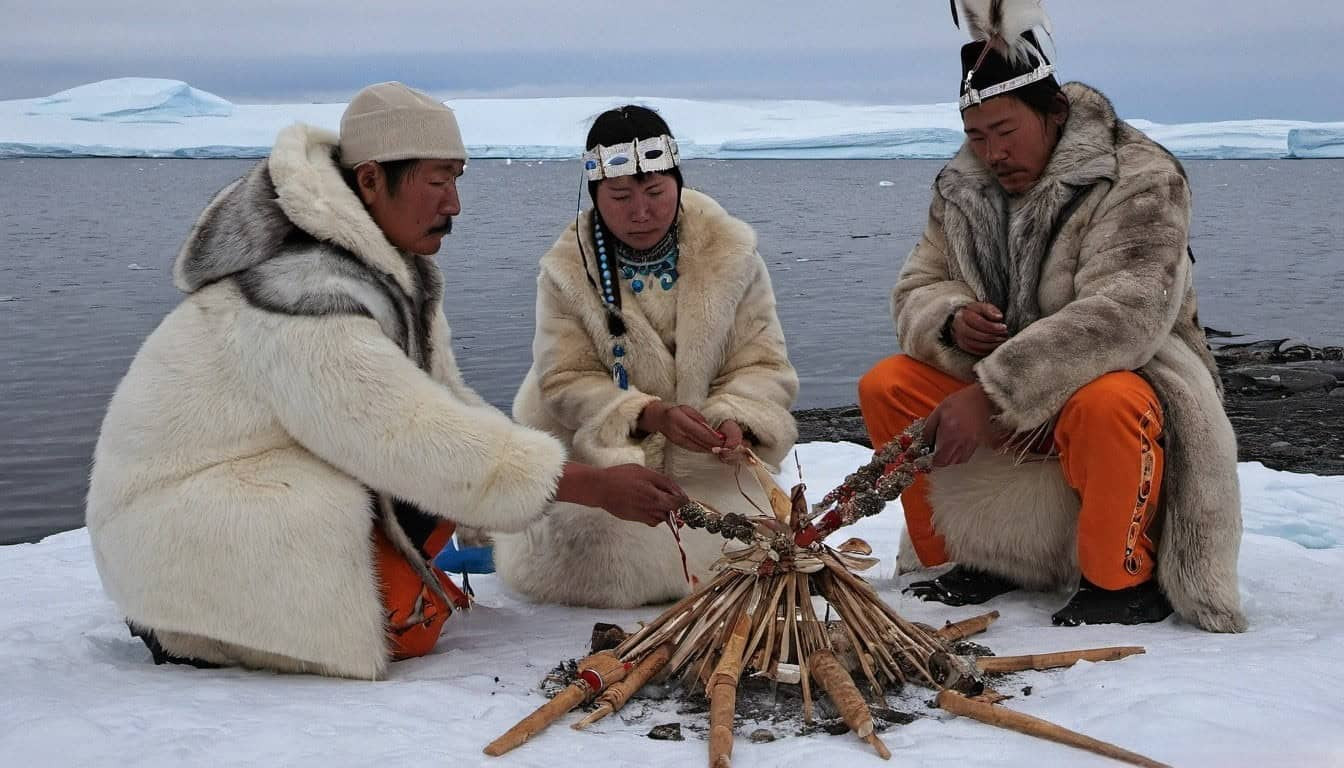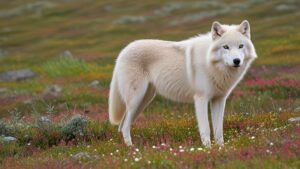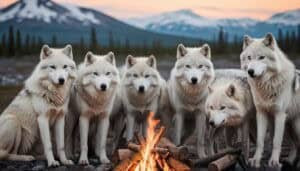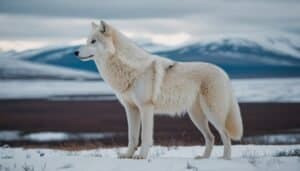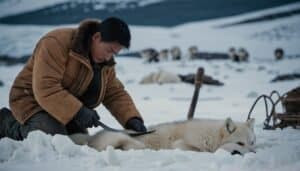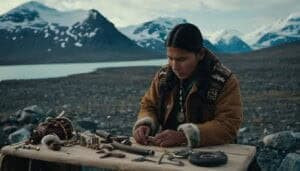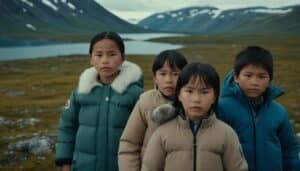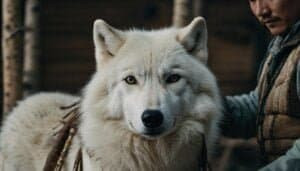Introduction
In traditional Arctic communities, Arctic wolves hold a revered place in cultural and ceremonial practices
This article explores the multifaceted roles these majestic animals play in various rituals, their symbolic significance, and the ways they are integrated into the cultural fabric of Arctic life. We’ll delve into historical contexts, the preservation of traditions, and how modern Arctic societies view and adapt these ancient practices
Roles of Arctic Wolves in Traditional Ceremonies
Arctic wolves hold a unique and respected position in the ceremonies of traditional Arctic communities. These majestic animals are not only central to many rituals but also symbolize the deep connection between humans and nature in these harsh, remote regions
Understanding the roles that Arctic wolves play in these ceremonies provides insight into the cultural significance and historical context of these traditions
Cultural Significance
In many Arctic cultures, the Arctic wolf is seen as a spiritual guide and protector. Their resilience and ability to thrive in the harsh Arctic environment symbolize strength, endurance, and adaptability—qualities highly valued by the communities living in these regions
The wolf is often considered a totem animal, representing wisdom and a deep connection to the land and its cycles. This symbolism is deeply embedded in the rituals and ceremonies, where wolves are revered and honored
Ceremonial Roles
Arctic wolves are featured prominently in various ceremonial roles. They are often included in initiation rites, where young members of the community are introduced to the spiritual world and the traditions of their ancestors
The presence of a wolf, whether physical or symbolic, is believed to confer protection and guidance to the initiates. In some ceremonies, the wolf is represented by masks or carvings, which are used in dances and storytelling to convey important cultural narratives
Another significant role of the Arctic wolf in ceremonies is as a mediator between the human world and the spiritual realm. Shamans, who are spiritual leaders in these communities, may call upon the spirit of the wolf during rituals to seek guidance, healing, or blessings from the spirits
The howling of wolves is often interpreted as messages from the spirit world, and shamans may mimic these howls to communicate with the spirits during their rituals
Historical Context
The historical context of using Arctic wolves in ceremonies dates back centuries, with roots in the animistic beliefs of indigenous Arctic peoples. These traditions have been passed down through generations, evolving but maintaining core elements that highlight the wolf’s importance
Early explorers and anthropologists documented these practices, noting the central role wolves played in the spiritual and everyday lives of Arctic communities. Artifacts such as wolf carvings, masks, and ceremonial attire found in archaeological sites provide tangible evidence of the long-standing reverence for wolves
One example is the Inupiat people of Alaska, who have a rich tradition of incorporating wolves into their spiritual practices. Historical records describe how the Inupiat believed the wolf to be a powerful spirit animal, capable of bestowing hunting prowess and protection against evil spirits
Similarly, the Chukchi people of Siberia have long viewed the wolf as a guardian spirit, essential for successful hunts and safeguarding the community from harm
Today, these historical practices are preserved and adapted by modern Arctic communities. Efforts are made to maintain the cultural heritage while ensuring the welfare of the wolves involved in these ceremonies
This includes respecting the natural behavior and habitat of the wolves, often using symbolic representations rather than live animals to honor their significance
Integration into Cultural Rituals
Arctic wolves are deeply integrated into the cultural rituals of traditional Arctic communities, reflecting the close bond between these animals and the people who share their environment
The integration of wolves into rituals is multifaceted, encompassing various practices that highlight the spiritual and practical importance of these animals
Ritual Practices
Ritual practices involving Arctic wolves often center around their symbolic representation
Traditional dances, for instance, frequently incorporate wolf masks and costumes. These performances are not merely artistic expressions but are imbued with spiritual significance. Dancers wearing wolf masks may mimic the movements and behaviors of wolves, invoking their spirit to bless the community with strength, protection, and guidance
These dances can be part of larger ceremonies, such as seasonal festivals, hunting celebrations, and rites of passage
In some communities, wolves are also involved in rituals related to hunting and survival. Given the harsh Arctic environment, hunting is a critical aspect of life, and the wolf, as a skilled hunter, serves as an important symbol
Rituals before a hunt may involve offerings to the wolf spirit, seeking its blessing for a successful and safe hunt. After the hunt, ceremonies may include thanksgiving rites where parts of the hunted animal are offered back to nature as a sign of respect and gratitude, acknowledging the role of the wolf in guiding the hunters
Community Participation
The integration of Arctic wolves into rituals is a communal affair, bringing together various members of the community. Elders often play a crucial role, imparting knowledge about the significance of the wolf and the proper conduct during rituals
Their teachings ensure that younger generations understand and respect the traditions. Community participation can also involve collective storytelling sessions where tales of wolves and their interactions with humans are shared, reinforcing the cultural narratives and moral lessons associated with these animals
Children and young adults are often encouraged to engage in these rituals from an early age, fostering a deep-seated respect for wolves and their symbolic meanings. Through participation in dances, songs, and storytelling, they learn the cultural values and spiritual beliefs of their community
This collective involvement ensures that the traditions are kept alive and relevant across generations
Preservation of Traditions
Preserving the traditions involving Arctic wolves is of paramount importance to many Arctic communities. This preservation is not only about maintaining cultural heritage but also about adapting practices to contemporary realities
With changing environmental and social conditions, some communities have shifted from using live wolves in ceremonies to symbolic representations, ensuring the animals’ welfare while still honoring their spiritual significance
Efforts to document and pass down these traditions are ongoing. Elders and cultural leaders work to record oral histories, ritual practices, and the meanings behind them
Educational programs and community workshops often focus on teaching the younger generation about the importance of these traditions. By integrating modern methods of documentation and education, Arctic communities strive to keep their cultural practices involving wolves vibrant and meaningful
In modern times, some Arctic communities also collaborate with researchers and conservationists to ensure that the cultural practices involving wolves are sustainable and do not harm the local wolf populations
These collaborations often include educational exchanges where the cultural significance of the wolf is shared with outsiders, promoting a broader understanding and respect for Arctic traditions
Symbolism and Sacredness
The Arctic wolf is a powerful symbol in traditional Arctic communities, embodying a range of sacred and spiritual meanings. These animals are revered not only for their physical prowess and adaptability but also for the deep symbolic connections they hold within the cultural and spiritual frameworks of Arctic peoples
Symbolic Meanings
Arctic wolves are often seen as symbols of strength, endurance, and survival. Their ability to thrive in the harshest of climates represents resilience, a quality highly valued by Arctic communities
The wolf’s keen hunting skills and social structure are also admired and mirrored in human behavior, emphasizing cooperation, loyalty, and the importance of community bonds
In addition to these qualities, Arctic wolves are viewed as messengers between the physical and spiritual worlds. Their howls, which can be heard across great distances, are believed to carry messages from the spirit world
This connection enhances their role in ceremonies and rituals, where their presence or representation is thought to facilitate communication with ancestral spirits and deities
The Arctic wolf’s white coat is also symbolic, representing purity, clarity, and the reflective qualities of snow. This purity is often associated with spiritual insight and the ability to see beyond the physical world into the realm of the spirits
Sacredness in Ceremonies
The sacredness of Arctic wolves is a central aspect of many ceremonies
Wolves are considered protectors and guides, their spirits called upon to provide strength and direction. In some cultures, shamans don wolf pelts or masks to embody the spirit of the wolf during rituals. This practice is believed to enhance the shaman’s power and ability to mediate between the human and spiritual realms
Ceremonial use of wolves can include offerings and prayers specifically directed to wolf spirits. These rituals may take place at significant times, such as the beginning of a hunt, during major life events, or at seasonal transitions
The presence of the wolf spirit is invoked to bless the proceedings, ensure success, and protect the participants from harm
The sacredness of the Arctic wolf is also reflected in the respectful treatment of these animals. While wolves may be hunted for their fur and meat, every part of the animal is used, and the act is accompanied by rituals that honor the wolf’s spirit
This practice underscores the belief in the interconnectedness of all life and the necessity of respecting the animals that provide for human needs
Myths and Folklore
Arctic wolves feature prominently in the myths and folklore of Arctic communities
These stories often depict wolves as wise and powerful beings, capable of extraordinary feats. In some tales, wolves are creators or ancestral beings who shaped the land and its inhabitants. These myths serve to reinforce the wolf’s esteemed status and its integral role in the natural and spiritual world
One common theme in Arctic folklore is the wolf as a teacher or guide. Stories often recount how wolves have helped humans by teaching them survival skills, guiding them through treacherous landscapes, or providing spiritual wisdom
These tales are more than entertainment; they are vital cultural transmissions that convey important lessons about respect for nature, the value of community, and the necessity of living in harmony with the environment
For example, the Inuit have numerous stories where the wolf plays a central role. One such tale involves a wolf leading a lost hunter back to his village, symbolizing guidance and protection. Another story tells of a wolf who transforms into a human to teach a community about the importance of cooperation and mutual support
The enduring presence of Arctic wolves in myths and folklore highlights their profound impact on the cultural and spiritual lives of Arctic peoples. These stories not only entertain but also educate, preserving the values and beliefs that are central to these communities
Specific Ceremonies Featuring Arctic Wolves
Arctic wolves play vital roles in various specific ceremonies within traditional Arctic communities. These ceremonies often blend spiritual, cultural, and practical elements, showcasing the integral part wolves hold in the cultural fabric of Arctic life
Types of Ceremonies
Arctic wolves are featured in a variety of ceremonies that mark significant events and transitions in the lives of community members
Some of the most notable ceremonies include:
Initiation Rites: These ceremonies mark the transition from childhood to adulthood. Young individuals may don wolf masks or participate in wolf dances, symbolizing their entry into a new phase of life guided by the wisdom and strength of the wolf
Hunting Rituals: Prior to embarking on hunts, communities conduct rituals to honor the wolf spirit, seeking its guidance for a successful hunt. These rituals often involve chanting, offerings, and the invocation of the wolf spirit through dances and prayers
Seasonal Festivals: Arctic wolves are celebrated during seasonal festivals, which mark the changes in the environment and the rhythms of the natural world. The presence of wolves in these festivals symbolizes resilience and adaptation to the harsh Arctic conditions
Roles in Specific Rituals
In specific rituals, Arctic wolves are depicted in various symbolic and literal forms:
Wolf Dances: Participants wear wolf masks and costumes, performing dances that mimic the movements and behaviors of wolves. These dances are believed to invoke the spirit of the wolf, providing protection and blessings to the community
Shamanic Rituals: Shamans, acting as intermediaries between the human and spiritual worlds, often incorporate wolf elements into their rituals. They may wear wolf pelts, use wolf howls in their chants, or call upon the wolf spirit to aid in healing, guidance, and spiritual journeys
Storytelling Sessions: Wolves feature prominently in traditional storytelling, with tales often recounted during communal gatherings. These stories serve to transmit cultural values and teachings, emphasizing the role of the wolf as a guide and protector
Modern Adaptations
As Arctic communities navigate the challenges of modernity, they have adapted their ceremonial practices to ensure the continued reverence for Arctic wolves while addressing contemporary concerns
Some of these adaptations include:
Symbolic Representation: To protect live wolf populations and respect modern conservation efforts, communities may use symbolic representations such as carvings, masks, and paintings in place of live animals in ceremonies
Educational Programs: Modern Arctic communities often incorporate educational programs that teach younger generations about the cultural significance of wolves and the importance of preserving these traditions. These programs may include workshops, storytelling sessions, and collaborative projects with cultural institutions
Collaborations with Conservationists: Arctic communities work with conservationists to ensure that their practices are sustainable and do not harm wolf populations. These collaborations often involve research and monitoring efforts, as well as the development of guidelines for ceremonial practices that respect both cultural traditions and wildlife conservation
An example of a modern adaptation is the annual festival held by the Inuit community, where symbolic wolf dances and storytelling sessions are central features. This festival not only celebrates the cultural heritage but also educates visitors and younger community members about the significance of the Arctic wolf in their traditions
Conclusion
Arctic wolves hold a revered and significant place in the traditional ceremonies of Arctic communities. From symbolizing strength and resilience to serving as spiritual guides and protectors, these majestic animals are deeply woven into the cultural fabric of Arctic life
The integration of wolves into ritual practices highlights the profound respect and interconnectedness between humans and nature, as seen in initiation rites, hunting rituals, and seasonal festivals. Symbolic representations in dances, storytelling, and shamanic rituals further emphasize the sacredness of wolves
The enduring presence of Arctic wolves in myths and folklore reinforces their symbolic meanings and the values they represent. Modern adaptations of these practices ensure the preservation of cultural heritage while aligning with contemporary conservation efforts
Through education and collaboration, Arctic communities continue to honor their traditions and the vital role of Arctic wolves, ensuring these practices remain vibrant and meaningful for future generations
